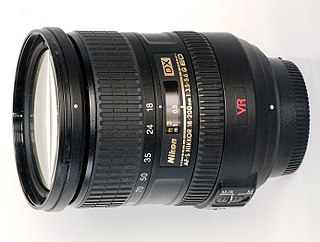 | |
| Maker | Sigma Corporation |
|---|---|
| Technical data | |
| Focal length | 35mm |
| Crop factor | 1.0 |
| Aperture (max/min) | f/1.4 - f/16 |
| Close focus distance | 30 cm / 11.8 in. |
| Max. magnification | 1:5.2 |
| Diaphragm blades | 9 |
| Construction | 13 elements in 11 groups |
| Features | |
| Short back focus | |
| Ultrasonic motor | |
| Lens-based stabilization | |
| Macro capable | |
| Application | Wide prime |
| Physical | |
| Max. length | 94 mm / 3.7 in. |
| Diameter | 77 mm / 3 in. |
| Weight | 665 g / 23.5 oz. |
| Filter diameter | 67 mm |
| Accessories | |
| Lens hood | Petal |
| Angle of view | |
| Diagonal | 63.4° |
| History | |
| Introduction | 2013 |
| Retail info | |
| MSRP | $899.00 USD USD |
The Sigma 35mm f/1.4 DG HSM Art is a wide angle prime lens made by the Sigma Corporation. [1] The lens was announced at the 2012 photokina trade fair. [2]

In photography and cinematography, a wide-angle lens refers to a lens whose focal length is substantially smaller than the focal length of a normal lens for a given film plane. This type of lens allows more of the scene to be included in the photograph, which is useful in architectural, interior and landscape photography where the photographer may not be able to move farther from the scene to photograph it.

In film and photography, a prime lens is a fixed focal length photographic lens, typically with a maximum aperture from f2.8 to f1.2. The term can also mean the primary lens in a combination lens system. Confusion between these two meanings can occur if context doesn't make the interpretation clear. People sometimes use alternate terms—primary focal length, fixed focal length, or FFL to avoid ambiguity.

Sigma Corporation is a Japanese company, manufacturing cameras, lenses, flashes and other photographic accessories. All Sigma products are produced in the company's own Aizu factory in Bandai, Fukushima, Japan. Although Sigma produces several camera models, the company is best known for producing high-quality lenses and other accessories that are compatible with the cameras produced by other companies.
The lens is produced in Canon EF mount, Nikon F-mount, Pentax K mount, Sigma's own SA mount, and the Sony/Minolta AF Mount varieties, all have the same optical formula. Since the lens covers full-frame sensors and includes an ultrasonic autofocus motor, it is fully compatible with most DSLRs on which it can be mounted physically. Reviews have noted excellent sharpness [3] and an overall performance on par with manufacturers such as Nikon and Canon, despite its price being significantly less than comparable offerings by those companies. [2]

Introduced in 1987, the EF lens mount is the standard lens mount on the Canon EOS family of SLR film and digital cameras. EF stands for "Electro-Focus": automatic focusing on EF lenses is handled by a dedicated electric motor built into the lens. Mechanically, it is a bayonet-style mount, and all communication between camera and lens takes place through electrical contacts; there are no mechanical levers or plungers.

The Nikon F-mount is a type of interchangeable lens mount developed by Nikon for its 35mm format single-lens reflex cameras. The F-mount was first introduced on the Nikon F camera in 1959, and features a three-lug bayonet mount with a 44 mm throat and a flange to focal plane distance of 46.5 mm. The company continues to use variations of the same lens mount specification for its film and digital SLR cameras.

A full-frame digital single-lens reflex camera (DSLR) is one with an image sensor format that is the same size as 35 mm format film. Historically, 35 mm was considered a small film format compared with medium format, large format and even larger.
The Art series of Sigma lenses can be connected to Sigma's USB dock, allowing the lens firmware to be updated and focus micro-adjustments to be configured at four different focus distances. [4]

















